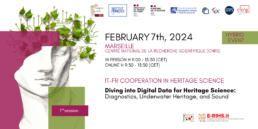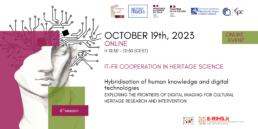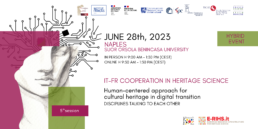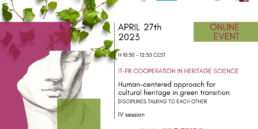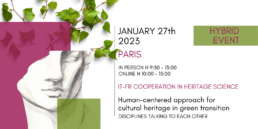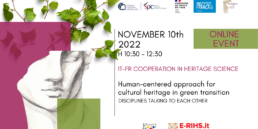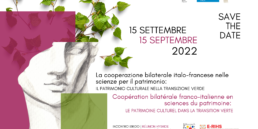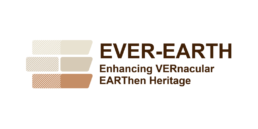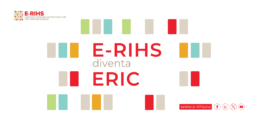IT-FR cooperation in Heritage Science
Taking Action in the Face of Extreme events
September 26th 2024 | Hybrid Event
In person H 8:30 - 13:00 (CEST) | Online H 9:00 - 13:00 (CEST)
Florence, Opificio delle Pietre Dure
Within the framework of the Italian-French bilateral cooperation in Heritage Science, the eighth event will be focused on “Taking Action in the Face of Extreme events”.
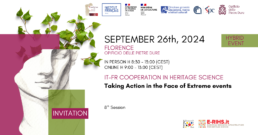
The IT-FR Bilateral cooperation in Heritage Science is pleased to announce the 8th event of its series, titled “Taking Action in the Face of Extreme events.” This hybrid seminar will focus on studies and research findings related to the protection and conservation of heritage materials in the event of natural and human-made calamities.
The event will take place at the Opficio delle Pietre Dure in Florence on the 26th September 2024.
This seminar is part of the event series promoted under the framework of the IT-FR Bilateral cooperation in Heritage Science, established following the Quirinal Treaty. The event is organised through the collaboration of various French and Italian institutions, including the French Ministry of Culture (Ministère de la Culture) and the Direzione Generale Educazione, ricerca e istituti culturali of the Italian Ministry of Culture (Ministero della Cultura), the Istituto di Scienze del Patrimonio Culturale del Consiglio Nazionale delle Ricerche (CNR ISPC), the Fondation des Sciences du Patrimoine, the Institut Français Italia and the French Embassy in Italy (Ambassade de France en Italie).
We believe that bringing together a diverse range of experts from France and Italy to exchange knowledge and findings will foster dialogue and joint actions between our countries in the protection of cultural heritage.
Registration is open!
To ease the organisation of the seminar, for both in-person and online participation, you need to register for the event.
Please remember that registration will be open until the 20th September 2024.
We look forward to seeing you on September 26th!
Presentations by speakers at the event are available here
SESSION 1: Protection and mitigation to avoid disaster
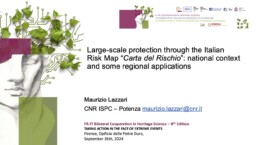
Large-scale protection through the Italian Risk Map “Carta del Rischio”: national context and some regional applications
The contribution focuses on the definition and presentation of the Risk Map of Italian Cultural Heritage, starting from a regional vision and ending with a regional application, taking the Basilicata region (southern Italy) as an example.
The risk map was born from the need to be able to prevent the impact of natural disasters (earthquakes, landslides, floods, etc.) on the cultural heritage exposed to them, but also the atmospheric pollution phenomena, which accelerate the structural degradation of the assets. It is an information system to support the scientific and administrative activities of the Institutes and state bodies responsible for the protection, safeguard and conservation of cultural heritage. It is based on the structure of a GIS, which is the most suitable technical tool for producing thematic cartographic representations combined with alphanumeric data.
The quantitative methodology for calculating risk using a matrix system is presented, starting from hazard maps (only for landslides for the specific case of Basilicata) and interpolating them with the cultural heritage map through the assignment of weights based on the importance of the assets. From the algebraic calculation between hazard and vulnerability, risk areas are defined in GIS, in which to identify the cultural heritage exposed to irreversible loss, to plan the necessary priorities of conservation interventions.
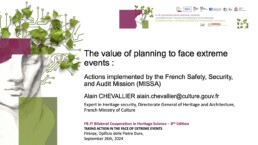
Risk analysis and emergency response
Cultural asset protection plans
In France, since the fire at the Cathedral Notre-Dame de Paris, existing preventive and protective measures have been greatly reinforced with the implementation of a cathedral safety plan, but the name of this plan has been changed to take into account not only artworks, but also historic monuments. This new awareness has brought the Ministries of Culture and the Interior (Police and Firefighters) closer together, with a view to pooling expertise and, in particular, the supervision of volunteers. A few points of understanding about cultural heritage safeguarding plans (CHSP) will be presented.
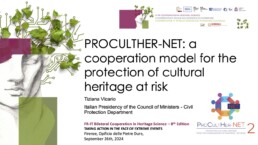
Pro CultHer-Net: a cooperation model for the protection of cultural heritage at risk
Co-funded by the European Commission (DG ECHO) within the Union Civil Protection Mechanism (UCPM), PROCULTHER initiatives aim to create a common language to build bridges between Disaster Risk Management (DRM) and Cultural Heritage (CH) sectors. The initiative emphasizes the necessity of involving DRM in cultural heritage protection, promoting shared operating procedures, and scaling up existing tools to enhance cooperation.
Key elements of this approach include:
- Nexus between Cultural Heritage and Disaster Risk Management: A win-win approach is essential for reducing risks posed by natural and man-made hazards to cultural heritage. Recognizing the importance of building bridges between these communities is crucial, as the inclusion of DRM actors adds significant value. CH should be considered a first priority by DRM community.
- Heritage as Humanity’s Treasure: Cultural heritage is a shared responsibility. A common basis for shared standard operating procedures is needed to enable effective and measurable interventions in this field.
- Technical Cooperation as a Tool for Dialogue: PROCULTHER projects highlight the interest in cultural heritage protection and the willingness of experts to engage in strengthened cooperation.
- No Need to Reinvent the Wheel: Existing tools, such as those developed by the UCPM, should be scaled up and shared to facilitate continuous learning and recognition of cultural heritage protection as a vital DRM sector.
- Beyond Response – Aiming for Sustainable Risk Reduction: Focusing solely on response approaches does not foster sustainable risk reduction strategies for cultural heritage and the communities that cherish it. Prevention and preparedness are essential components of both disaster management and sustainable development, as disasters are often unresolved issues of development.
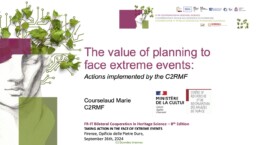
The Value of Planning to cope with Extreme Events: Actions implemented by the C2RMF
The presentation highlights the actions of the French Center for Research and Restoration of Museums (C2RMF) in response to climate change and extreme events that threaten cultural heritage. It underscores the importance of planning to improve emergency response and minimize disaster impacts, particularly through safeguarding plan workshops for museums and heritage institutions. These workshops help enhance risk knowledge, foster a culture of preparedness, and develop robust disaster response strategies. Key actions include close collaborations between cultural institutions, emergency services, and partners such as Blue Shield France, raising risk awareness and providing specialized training. The objective is to advance research by addressing emerging challenges such as flooding and the evolving risks associated with climate change. Simultaneously, the focus remains on developing innovative tools and methods to strengthen the protection of cultural heritage.
SESSION 2: Emergency intervention on heritage
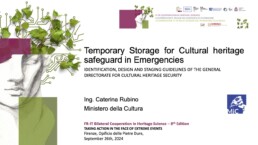
Temporary Storage for protecting Cultural Heritage in Emergencies
Guidelines of the General Directorate for Cultural Heritage Security (MIC)
In the event of natural disasters, safeguarding cultural heritage may require the removal of artifacts from damaged buildings and their temporary storage in dedicated facilities. These facilities must meet the necessary safety and functionality requirements, while also ensuring operational efficiency, considering the various activities involved (transportation, handling, placement, initial interventions, etc.). The guidelines for identifying, adapting, protecting, and setting up storage facilities for the temporary storage of movable cultural heritage, along with associated restoration laboratories, were developed by a multidisciplinary working group under the coordination of the Directorate General for the Security of Cultural Heritage. These guidelines detail the optimal requirements for emergency storage facilities, assessed based on the experience gained by the Ministry of Culture during various events that have affected the national territory. A brief mention is made of both existing and planned storage facilities.
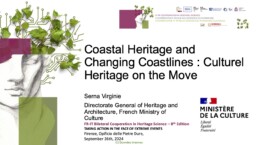
Coastal Heritage and Changing Coastlines: Cultural Heritage on the Move
From the boat to the marinas, from the bunker to the beach, the coastline in its complex objects, its landscapes, its multifaceted space, its management and its plural governance poses itself as a place of memory and innovation.
As indicated in the Coastal Law of January 3, 1986, the coastline is a geographic entity made up of geographical forms, landscape sequences and cultural assets, all vulnerable and fragile.
As a boundary separating land and sea, mobile by nature, the coastline is the first benchmark of this coastal dynamic, which is now accelerating. The coastline is a landscape form, a reference line, an administrative boundary and a legal concept that was developed very early on. Today, more than ever, it is observed and mapped. Numerous scientific research programs call for detailed knowledge of its future route and have long warned of the erosion of cultural properties. How can we use this knowledge and these anticipation tools to better understand prospective reflection on coastal heritage?
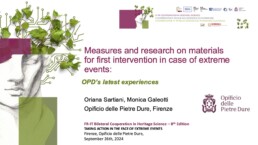
Measures and research on materials for first intervention in case of extreme events: OPD’s latest experiences
In its long history, the OPD has had many recurrent experiences with events that have caused immediate and catastrophic effects. From a methodological point of view, the OPD therefore has to act after the damage has occurred, with the recovery, securing and restoration of the affected works. The emergency experience teaches us that, for a damaged artwork, waiting the long time needed to carry out a complete restoration is detrimental for the recovery of its materials and its artistic values. Securing and protection is therefore to be understood as an absolute priority for the preservation and transmission to the future of the cultural heritage artefact. The interventions are carried out with operational phases and procedures calibrated on many different types of artworks, with different constituent materials and thus diversified conservation conditions and needs, according to a schedule dictated primarily by the conservation urgency of the artefact. There is therefore the need for new materials that can meet the specific requirements of such delicate operations. The second part of the presentation will illustrate the research carried out by the OPD on materials suitable for the temporary and urgent consolidation of damaged artworks in the aftermath of a disaster. The activity is focused on the so-called Volatile Binding Media, which have the remarkable property to sublimate at room temperature, thus allowing the design and implementation of the restoration intervention. Among these molecules, cyclododecane has a long history of use, but in recent years its supply has become difficult due to some production problems. This has encouraged the search for new materials to be used as volatile binders, whose properties and performance are the subject of our ongoing research. Finally, the preliminary application to a case study will be shown, a Crucifix recovered after the 2016 earthquake in Umbria.
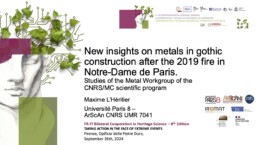
New insights on metals in gothic construction after the 2019 fire in Notre-Dame de Paris
Studies of the Metal Workgroup of the CNRS/MC scientific program
Iron and lead are omnipresent in medieval great stone monuments. The restoration yard in Notre-Dame-de-Paris following the 15th April 2019 fire gave a unprecedented access to an entirely scaffolded structure and the possibility to study and sample hundreds of metal artefacts directly on site, thanks to a close collaboration with the commissioner (RNDP), the Ministry of Culture services (MC) and the French National Research Centre (CNRS). This unique opportunity allowed to question the evolution of practices related to these metals over the centuries: quality and use for construction, provenance, recycling… This communication aims to present the interdisciplinary researches carried out by the “Metal workgroup” of CNRS/MC Notre-Dame-de-Paris scientific program over the past five years and some of its results.
Further information
The event is eighth of a series of seminars.
- The first event held in Rome on September 15th, 2022
- The second event held online on November 10th, 2023
- The third event held in Paris on January 27th, 2023
- The fourth event held online on April 27th, 2023
- The fifth event held in Naples on June 28th, 2023
- The sixth event held online on October 19th 2023
- The seventh event held in Marseille on February 7th 2024
For further information about previous events, we invite you to visit the pages dedicated to the Italian-French partnership in heritage science.
